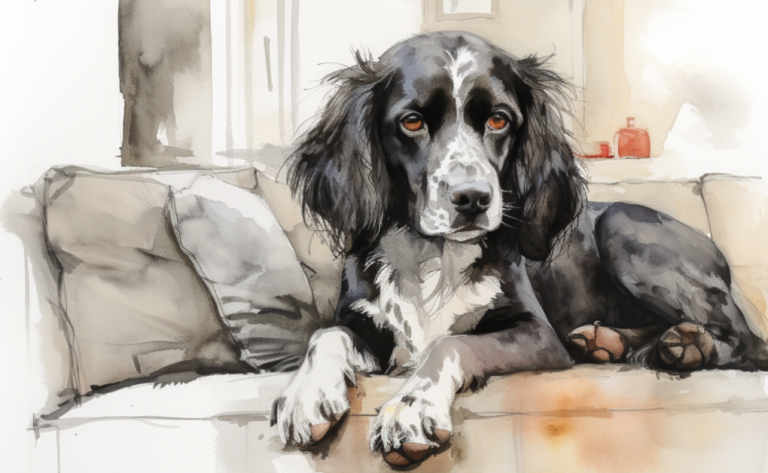Understanding Gastrointestinal Foreign Bodies in Dogs
What is it?
How is it Treated?
Breed Predispositions
Labrador Retriever German Shepherd Golden Retriever Boxer Great Dane Bulldog Doberman Pinscher Rottweiler Irish Setter Weimaraner
Introduction
After a long day at work, Julie returned home to find her beloved Labrador Retriever, Max, looking unusually lethargic and experiencing bouts of vomiting. Concerned about her furry companion’s well-being, she immediately took Max to the veterinarian for an examination. The vet discovered that Max had ingested a foreign body, which had become lodged in his intestines, causing his distress.
Foreign bodies in dogs are objects that enter a dog’s intestinal tract. They may be ingested accidentally or intentionally. Intestinal wall foreign bodies are usually found inside the stomach of the dog. However, they can also occur anywhere else in the gastrointestinal tract. Obstructions occur most often in the small intestine (63%), but foreign objects are found throughout the digestive system.
These include bones, toys, plastic bags, balloons, rubber bands, coins, batteries, buttons, screws, nails, glass fragments, toothpicks, hair clippings, and other items. Intestinal foreign body ingestion occurs most commonly in puppies and young dogs. This is due to the small size of their digestive system.
Causes of Gastrointestinal Foreign Bodies in Dogs
Dogs can ingest various items, leading to intestinal foreign bodies, essentially indigestible objects or items too large to pass through their gastrointestinal (GI) tract. Commonly ingested foreign bodies include an array of items such as toys, bones, clothing, plastic materials, string or yarn, hair accessories, small household items, dental care products, jewelry, rocks, pieces of fabric, plant material, food packaging, and even fishing gear.
Specifically, dogs, especially curious puppies or those with an indiscriminate appetite, can be prone to such ingestion. It underscores the importance of owners being watchful and ensuring that harmful items are kept out of their dogs’ reach.
Ingested foreign bodies in dogs stem from both environmental and behavioral causes:
- Curiosity: Dogs and puppies, due to their innate curiosity, may chew or swallow objects they encounter, leading to the ingestion of foreign bodies.
- Boredom: Insufficient mental stimulation can drive dogs towards destructive behavior, like chewing on various objects, which can result in the accidental ingestion of foreign material.
- Teething: As puppies undergo teething, they often chew on various objects to soothe their discomfort, which raises the risk of swallowing foreign bodies, including sharp objects.
- Inappropriate diet: Offering dogs cooked bones and indigestible food items or allowing them access to trash can increase their chances of ingesting items that can cause bowel obstructions.
- Scavenging behavior: Dogs with a natural tendency to scavenge are more likely to consume foreign objects they find, including linear foreign bodies like string or yarn, which are especially dangerous.
- Lack of supervision: Dogs left without supervision or with access to potentially harmful objects face a higher risk of ingesting foreign bodies.
- Pica: This is a medical condition where dogs compulsively eat non-food items. This behavior could be linked to underlying medical issues such as nutritional deficiencies or gastrointestinal problems.
To avoid the risk of intestinal foreign bodies in dogs, including esophageal foreign bodies and cases where a foreign body has perforated the GI tract, pet owners should ensure a safe environment by removing or securing potentially harmful items. In addition, they should provide appropriate chew toys, supervise their pets during outdoor activities, and closely monitor for signs that a foreign body is present. This level of vigilance is particularly crucial when it comes to potentially ingesting items like a food bolus or a fish bone, which could cause significant issues.
Symptoms of Intestinal Foreign Bodies in Dogs
The clinical signs of intestinal foreign bodies in dogs can fluctuate based on factors like the location, size, and nature of the ingested object. Key symptoms to look out for in both dogs and cats include:
- Changes in bowel movements, such as diarrhea or constipation
- Loss of appetite
- Abdominal pain and discomfort
- Decreased energy or weakness
- Signs of electrolyte imbalance
- Swelling or distension in the abdomen
- Evident foreign object
- Fever
These symptoms could indicate a GI obstruction along the gastrointestinal tract, most commonly in the stomach or intestines. The degree of obstruction and the type of foreign body can cause the clinical signs. If you observe any signs of a foreign body or suspect your pet has swallowed a foreign item, immediate veterinary consultation is imperative. The presence of a foreign body in the intestinal or stomach region can result in a life-threatening situation, demanding swift intervention to ward off severe complications.
Other symptoms include diarrhea, anorexia, depression, weakness, and dehydration.
Diagnosis of Gastrointestinal Foreign Bodies in Dogs
Determining the presence of ingested FBs (foreign bodies) in dogs generally requires a blend of clinical assessment, case history review, and diagnostic imaging. The following steps give an insight into the process:
Clinical Assessment
The process usually begins with a thorough physical examination by the veterinarian, which includes palpating the abdomen to check for any signs of pain, swelling, or any abnormal masses that might suggest the presence of a foreign body.
Case History Review
The veterinarian will inquire about the dog’s medical history, possible encounters with foreign objects, and the timeline and development of symptoms. This information is vital in assessing the probability of foreign body ingestion.
Radiography (X-rays)
Abdominal radiographs, or X-rays, are often the first imaging technique to identify gastrointestinal foreign bodies. In addition, they can help detect radiopaque objects like bones, stones, or toys and signs of intestinal obstruction such as gas or fluid buildup in the intestinal loops.
Ultrasound
If the foreign object is not visible on X-rays, an ultrasound may be performed to obtain a more detailed image of the gastrointestinal tract. In addition, ultrasounds can help identify radiolucent foreign bodies, such as plastic or rubber, and track the movement of intestinal contents, giving further evidence of a blockage.
Contrast Studies
In certain situations, the veterinarian may conduct a contrast study. This involves the administration of a contrast agent like barium, either orally or rectally, to better highlight the gastrointestinal tract on X-rays. This technique can help pinpoint the foreign body’s location and track the contrast material’s flow through the intestines. In these cases, X-rays are taken over several hours to monitor the movement.
Gastrointestinal Endoscopy
In some cases, the veterinarian may resort to gastrointestinal endoscopy. This involves using a flexible tube fitted with a camera and light source inserted via the dog’s mouth or anus to examine the gastrointestinal tract. This method also offers the possibility of endoscopic removal of some foreign objects, eliminating the need for surgery.
Exploratory Surgery
If other diagnostic methods fail to provide conclusive results or the dog’s condition deteriorates rapidly, exploratory surgery may be performed. This is a crucial step for diagnosis and surgical intervention, allowing the veterinarian to locate and extract the foreign body.
Diagnosing gastrointestinal foreign bodies in dogs is critical in forming an appropriate treatment plan and averting potentially fatal complications. In addition, prompt recognition and swift treatment can significantly enhance the prognosis for dogs with ingested foreign bodies.
Treatment of Gastrointestinal Obstruction in Dogs
Management strategies for intestinal foreign bodies in dogs hinge on several considerations, such as the nature, location, and size of the ingested foreign body and the severity of the dog’s symptoms. The two primary treatment paths are non-surgical intervention and veterinary surgery.
Non-Surgical Intervention
In instances where the foreign body is small, non-toxic, and not causing severe symptoms or obstruction, the veterinarian might opt for a “wait and see” approach.
This entails close observation of the dog for any changes in its condition while providing supportive care, including fluid therapy, pain management, and medications to stimulate gastrointestinal motility. The foreign body is expected to naturally navigate the GI tract without requiring surgical removal.
Endoscopy presents another non-surgical treatment option. A flexible tube fitted with a camera and light source is inserted through the dog’s mouth or anus to visualize and, if possible, extract the foreign body. In addition, endoscopy can be an effective remedy for specific types of foreign bodies, such as those trapped in the esophagus, stomach, or colon, given they can be safely retrieved using specialized endoscopic tools.
Surgical Intervention
Surgical intervention often becomes the most effective treatment strategy when the foreign body is large, sharp, and toxic, causing a complete bowel obstruction or significant symptoms and complications. An exploratory laparotomy, a form of intestinal surgery, is performed by the veterinarian to locate the foreign body, evaluate the state of the surrounding tissues, and proceed with the foreign body removal. In situations where sections of the intestine are damaged, intestinal resection and anastomosis may be necessary, which involves removing the damaged parts and reconnecting the healthy segments.
The dog will require careful monitoring, pain management, and supportive care to foster healing and recovery post-surgery. This may include intravenous fluids, antibiotics to thwart infection, and gradual food reintroduction once the dog’s gastrointestinal function returns to normal.
Prevention of Intestinal Foreign Bodies in Dogs
Preemptive measures to circumvent intestinal foreign bodies, or GI foreign bodies, in dogs, pivot around reducing the possibility of your dog consuming inappropriate objects. Here are some proactive strategies to safeguard your canine friend:
- Dog-Proof Your Surroundings: Ensure small, easily swallowed items such as toys, clothing, and household trinkets are beyond your dog’s reach. Ensure cabinets, drawers, and trash cans are secure to prevent your dog’s access to potentially dangerous items.
- Safe Chew Toys: Cater to your dog’s inherent chewing instincts by providing appropriate and safe chew toys. The toys should be sturdy and tailored to your dog’s size and chewing vigor to mitigate the risk of them breaking or ingesting fragments, thus avoiding FB ingestion.
- Monitor Playtime: Supervise your dog during its play sessions, both indoors and outdoors, to ascertain it doesn’t inadvertently pick up and swallow anything harmful.
- Regular Environment Inspection: Regularly assess your dog’s living areas, encompassing both indoor and outdoor spaces, for any small objects or debris that could pose a threat.
- Dog Training: Inculcate basic commands in your dog, such as “leave it” or “drop it,” which can prove instrumental in preventing them from swallowing potentially perilous items.
- Avoid Cooked Bones: Cooked bones can fracture and cause blockages or injuries to the gastrointestinal tract, acting as a linear foreign body. Instead, provide raw bones suitable for your dog’s size or choose bone-free alternatives.
- Balanced Diet: Ascertain your dog is receiving a balanced diet to prevent nutritional deficiencies that could contribute to pica or the consumption of non-food items.
- Consistent Feeding Routine: A regular feeding schedule can help curb scavenging behavior.
- Address Underlying Medical or Behavioral Issues: If your dog exhibits an underlying medical condition or a behavioral issue, such as pica, collaborate with your veterinarian to tackle and manage the problem, reducing the risk of foreign body ingestion.
Implementing these precautions and maintaining a safe and monitored environment for your dog can substantially diminish the likelihood of your pet dealing with an intestinal foreign body. However, if you suspect your pet has ingested a foreign object, seek veterinary assistance immediately, even if the object seems smooth enough to pass. Remember, a dog’s health can change rapidly, even days after surgery or other interventions.
Frequently Asked Questions
Disclaimer: The information provided on this veterinary website is intended for general educational purposes only and should not be considered as a substitute for professional veterinary advice, diagnosis, or treatment. Always consult a licensed veterinarian for any concerns or questions regarding the health and well-being of your pet. This website does not claim to cover every possible situation or provide exhaustive knowledge on the subjects presented. The owners and contributors of this website are not responsible for any harm or loss that may result from the use or misuse of the information provided herein.

